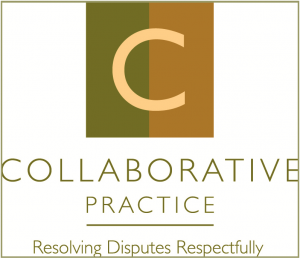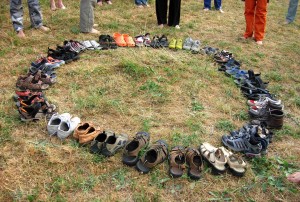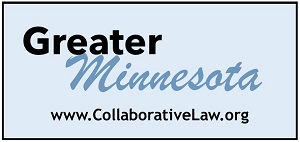Since its inception in Minnesota 30 years ago, the Collaborative Divorce process has helped families in all 50 states and more than 25 countries find a healthier way to end their marriage without going to court. However, this respectful alternative to contested divorce has largely remained unavailable to families in greater Minnesota. The recent advent of virtual practice and Zoom meetings has changed this landscape and opened up new possibilities for the statewide availability of Collaborative Divorce.
The Collaborative Divorce process was created in 1990. Minnesota attorney Stu Webb, discouraged by the emotional and financial side effects of adversarial divorce, piloted a new approach in which attorneys would be involved for settlement purposes only. Because Collaborative divorce attorneys were disqualified from going to court, these attorneys needed to become effective and creative negotiators and problem solvers. The result was a process in which divorcing couples could design customized outcomes for their families and not go to court.
As the Collaborative Divorce concept grew throughout North America and the world, it evolved into a team process. By using specially trained neutral experts in child development, family systems and divorce-related finance in addition to their Collaborative attorneys, clients are able to bring this added expertise to their parenting and financial resolutions, and likely reduce the financial cost of their divorce. The process is tailored to the needs of the family using professionals based on the skills and expertise they need.
It has been an unfortunate reality for accessibility that specially trained Collaborative professionals are typically concentrated in metro areas, including in Minnesota. But with the social distancing required by the pandemic, almost all divorce professionals are working with and representing clients online, typically through Zoom meetings. This means that a couple’s distance from Collaboratively trained professionals is no longer an obstacle. Individuals in greater Minnesota, can now have access to a full Collaborative team without leaving their homes.
To learn if a Collaborative Divorce is right for you and your family, please visit the website of the Collaborative Law Institute of Minnesota at www.collaborativelaw.org. There you will find detailed information about the Collaborative process, as well as names and bios of Collaborative professionals who practice this family-friendly, problem-solving, and future-focused process. Collaboratively trained professionals will be happy to offer you free informational meetings via teleconferencing to help you make the decision about whether this process, and a particular attorney or neutral professional, feels right for your needs.
Collaborative Practice Highlights:
- The entire process is legally and ethically done outside of court
- The result of the process is customized to the particular needs of a divorcing couple and/or family
- Clients can build a team of Collaboratively trained attorneys, neutral financial experts, mediators and mental health professionals (coaches and child/family specialists) who focus on problem solving and dispute resolution
- Collaborative professionals can offer specialized ala carte services in specific areas of particular need for clients, e.g., financial plans, parenting plans, conflict resolution, preparation and review of legal documents, and more.
- Collaborative Law Institute of Minnesota (CLI) website: collaborativelaw.org
- Find a Professional: https://www.collaborativelaw.org/find-a-professional/
- CLI Blog: collaborativedivorceoptions.com
- CLI Mailing address: 4707 Highway 61 N, #217 | White Bear Lake, MN 55110
The Collaborative Law Institute of Minnesota and the North Dakota Collaborative Law Group are nonprofit organizations focused on transforming the way families divorce by helping them create customized solutions and stay out of court. For more information or to find a Collaborative professional near you visit www.collaborativelaw.org (CLI) or www.nddivorce.com (NDCLG)
About the Author: Shared by the Collaborative Law Institute of Minnesota
Shared by the Collaborative Law Institute of Minnesota
Public Education Committee
Frustrated with the world of politics today? Unless you are reading this from your hospital bed, having just awakened from a long coma, I am going to guess the answer is yes. Whether you are a Democrat or a Republican, it’s likely that you have about had it with all of the acrimony and with the arguments being made by “the other side”. Probably the one thing we can all agree on is that everyone on “the other side” is quite disagreeable, both in their opinions and their manner of expressing their views.
If you have bravely ventured out into the world of political discourse in an attempt to influence “the other side”, whether at a gathering of friends or family, or on some social media site, there is a pretty good chance you came away even more frustrated after the experience. Any naïve thoughts you may have had about the other person changing their mind likely hit a brick wall that, by the end of the exchange, had become, if anything, even stronger in its resistance. If “the other side” argued back at you there is a pretty good chance that your brick wall got fortified as well. You and “the other side” achieved the very opposite of what you both wanted to achieve, and you both were left in a state of frustration.
As a divorce lawyer, I am struck by how similar all of this is to how most couples behave when they are in conflict. I am hoping there is something about watching these political arguments that may create a true learning opportunity for these couples. The reality that I just described; the dynamic that most arguments lead to chaos, frustration, and a deepening of divisions is an important insight. And what better time to learn it than when you are going through a divorce.
Trust me, as someone who has “been through” numerous divorces, the maddening events that are playing out on the political stage, bear an amazing resemblance to conversations I have regularly observed in my office during the past three decades. Two people, seized with emotions, bent on getting another person to agree with them, stay awake at night thinking of great arguments to persuade their spouse that they are right, or worse, thinking of “good” attorneys who can do that for them.
If you are in the middle of it (either politics or divorce), you are likely so caught up in your frustration with “the other side” that you have little insight about what you are doing that is actually making your life worse. However, if you are able to stand back, if only for a moment, both with the political arena and arguments with divorcing couple, it is fairly easy to see that all we are doing is pouring gas on a raging fire. Once you come to that realization, you may find yourself wondering what the alternative might be. Our inner voice immediately retorts that “we can’t just give in”, thinking, from the standpoint of our ego, that fight or flight are the only true options. Is there a third option?
There is. It has different names, but the most common phrase that negotiators use is “interest-based bargaining.” I will skip that jargon and simply call this alternative “dialogue” for the moment. Dialogue, in the sense I am using it, is one of those ideas that is simple but not easy. It starts with the idea of letting go of arguments and changing minds and focusing instead on seeking common ground or at least a basis for common understanding. What I have observed, at least with divorcing couples, is that if we can reframe the discussion away from “arguments to change minds” and on to dialogues aimed at achieving common understanding, it is possible to achieve common goals. This type of dialogue is a central tenet of something called Collaborative Divorce. To learn more about Collaborative Divorce, go to www.collaborativelaw.org. In the meantime, watch what is happening on the political stage and see if there might be some valuable life lessons that will help us become a better nation, and better families.
About the Author Ron Ousky, JD, is a Collaborative Attorney and mediator who has dedicated his practice to making sure that families facing conflict understand their options. He believes that families facing divorce are in a unique situation to make a better life for their families and he is dedicated to helping them find the resources to build a better future. For more information about his practice go to www.ousky.com
Ron Ousky, JD, is a Collaborative Attorney and mediator who has dedicated his practice to making sure that families facing conflict understand their options. He believes that families facing divorce are in a unique situation to make a better life for their families and he is dedicated to helping them find the resources to build a better future. For more information about his practice go to www.ousky.com
 April is Autism Awareness Month, the two month anniversary of the Marjory Stoneman Douglas High School shooting, and the 19th anniversary of Columbine. Why talk about ASD and school shootings in the same sentence? And why a divorce blog? I will get to that. But as a lawyer-mom, these two issues are at the forefront of my mind, and probably the minds of many parents and educators these days. We should rest assured that our kids would know what to do during a lock-down because they have spontaneous drills throughout the year, right? Ugh…what am I saying? The fact that kids NEED lockdown drills is downright outrageous! Nonetheless, I wondered what the younger kids are told and what happens during these drills. Well, lucky me, when I recently volunteered in my son’s elementary school classroom, the school had a lock down drill. And one word sums up the experience: chilling.
Lockdown drills are very different from the fire and tornado drills we had as kids. I’m sure everyone remembers the fire drills – exit the classroom quickly and get away from the building. Or the tornado drills – go out to the hallways, away from the doors and windows, and cover your head with your hands. Up until about 1999, THOSE were the drills Minnesotan kids experienced. In fact, most the time, much to our teacher’s chagrin, we were laughing and joking around. A lock down drill, however, has a very different vibe. The kids must be EXTREMELY quiet. They huddle into a specific area and are instructed to remain eerily still. This had been a bustling class (and school) just moments before, but now it was so quiet, you could hear a pin drop. This was a class of 30 second graders, so I was stunned at the deafening silence. Just when I thought it was over (it seemed like forever, but was probably two minutes) someone rattled the door handle. Forcefully. Not a peep from the kids, but I jumped. Luckily, they didn’t see me or they might have erupted into giggles. We had to continue to remain quiet and motionless. Interestingly, I don’t remember what happened next; that is, I don’t recall if there was a bell or another signal indicating the drill was over (I think I was sort of in shock). The kids went about their business, working on their projects, like it was no big deal. Only it was a big deal. At least it was to me and the other adults in the room. I just looked at the staff, wide-eyed, and shook my head.
School lock downs are now a reality for school-aged children. It makes my heart ache. I asked my son that evening why they have lockdowns and he nonchalantly said it was in case anyone wants to break into the school. That was it. Simple enough. But as we grown-ups know, there is nothing simple about this.
My son is a “mover and a crasher,” so I was relieved he made it through the drill. But I thought about the other high-needs/special-needs kids in his school. For any child who has physical needs or doesn’t cognitively understand the drill, simply can’t be quiet and remain calm, needs to move, or overreacts when accidentally bumped or touched by a classmate, what would that child do in this drill? Or, God forbid, in a REAL situation? With more and more kids being diagnosed with ASD, what protocols are in place for them? Is there a special section in their IEP about drills? There ought to be.
This made me think about special-needs kids whose parents are going through a divorce. The teachers are aware of kids’ needs (or should be). So, too, should the divorce team. A child’s symptoms often reemerge or worsen when they are stressed, which could happen during parental conflict and/or separation. Child specialists can work with the parents and the child’s pediatrician and/or therapist to help create a parenting plan that is in the child’s best interests. Like it or not, otherwise fit and loving parents need to work together for there children’s sake. Fortunately, the Collaborative process can help parents really focus on their kids, by putting them in the center, rather than the middle, of the divorce process. Every family situation is unique. Every family and every child deserve a creative plan to help move them forward, restructure, and get to a new “normal.” Drill and lockdown protocols included.
April is Autism Awareness Month, the two month anniversary of the Marjory Stoneman Douglas High School shooting, and the 19th anniversary of Columbine. Why talk about ASD and school shootings in the same sentence? And why a divorce blog? I will get to that. But as a lawyer-mom, these two issues are at the forefront of my mind, and probably the minds of many parents and educators these days. We should rest assured that our kids would know what to do during a lock-down because they have spontaneous drills throughout the year, right? Ugh…what am I saying? The fact that kids NEED lockdown drills is downright outrageous! Nonetheless, I wondered what the younger kids are told and what happens during these drills. Well, lucky me, when I recently volunteered in my son’s elementary school classroom, the school had a lock down drill. And one word sums up the experience: chilling.
Lockdown drills are very different from the fire and tornado drills we had as kids. I’m sure everyone remembers the fire drills – exit the classroom quickly and get away from the building. Or the tornado drills – go out to the hallways, away from the doors and windows, and cover your head with your hands. Up until about 1999, THOSE were the drills Minnesotan kids experienced. In fact, most the time, much to our teacher’s chagrin, we were laughing and joking around. A lock down drill, however, has a very different vibe. The kids must be EXTREMELY quiet. They huddle into a specific area and are instructed to remain eerily still. This had been a bustling class (and school) just moments before, but now it was so quiet, you could hear a pin drop. This was a class of 30 second graders, so I was stunned at the deafening silence. Just when I thought it was over (it seemed like forever, but was probably two minutes) someone rattled the door handle. Forcefully. Not a peep from the kids, but I jumped. Luckily, they didn’t see me or they might have erupted into giggles. We had to continue to remain quiet and motionless. Interestingly, I don’t remember what happened next; that is, I don’t recall if there was a bell or another signal indicating the drill was over (I think I was sort of in shock). The kids went about their business, working on their projects, like it was no big deal. Only it was a big deal. At least it was to me and the other adults in the room. I just looked at the staff, wide-eyed, and shook my head.
School lock downs are now a reality for school-aged children. It makes my heart ache. I asked my son that evening why they have lockdowns and he nonchalantly said it was in case anyone wants to break into the school. That was it. Simple enough. But as we grown-ups know, there is nothing simple about this.
My son is a “mover and a crasher,” so I was relieved he made it through the drill. But I thought about the other high-needs/special-needs kids in his school. For any child who has physical needs or doesn’t cognitively understand the drill, simply can’t be quiet and remain calm, needs to move, or overreacts when accidentally bumped or touched by a classmate, what would that child do in this drill? Or, God forbid, in a REAL situation? With more and more kids being diagnosed with ASD, what protocols are in place for them? Is there a special section in their IEP about drills? There ought to be.
This made me think about special-needs kids whose parents are going through a divorce. The teachers are aware of kids’ needs (or should be). So, too, should the divorce team. A child’s symptoms often reemerge or worsen when they are stressed, which could happen during parental conflict and/or separation. Child specialists can work with the parents and the child’s pediatrician and/or therapist to help create a parenting plan that is in the child’s best interests. Like it or not, otherwise fit and loving parents need to work together for there children’s sake. Fortunately, the Collaborative process can help parents really focus on their kids, by putting them in the center, rather than the middle, of the divorce process. Every family situation is unique. Every family and every child deserve a creative plan to help move them forward, restructure, and get to a new “normal.” Drill and lockdown protocols included.
 The professionals on a team are, generally speaking, the two attorneys, a neutral financial professional, a neutral child specialist, and a neutral divorce coach. Although the inclusion of financial and mental health professionals in the divorce process is nothing new, the manner in which they are used in the Collaborative process is unique. The attorneys’ roles are different in Collaboration, as well. While each spouse retains his or her own attorney, the attorneys work together to help the clients achieve an outcome that works for the entire family. The attorneys give legal advice to their individual clients, but more importantly, they help their clients realize what their interests and goals are. The objective of Collaboration is to get to a place where everyone is OK (a win-win) rather than a win-lose. The attorneys are trained in the Collaborative model and interest-based negotiation.
A financial neutral helps the divorcing couple with property division and cash flow. Financial neutrals are financial experts and are CPAs, CDFAs, and CFSs who are trained in the Collaborative process and who understand the legal process.
A child specialist is a neutral who helps the couple with creating a comprehensive and viable parenting plan. The child specialist is a therapist who is also trained in the Collaborative process. The child specialist is the voice of the children and not only helps the children during the divorce process, but helps parents help their children during this transition.
A divorce coach is also a therapist and a neutral in this process. The coach’s role is to the help the couple communicate better. It is important for each spouse to have a voice in this process and the coach can help with that. In high conflict cases, a coach helps the process move along more smoothly.
Although it seems like there are a lot of professionals involved in Collaboration, every professional has a specific role. In a non-collaborative case, the attorneys are acting as financial advisor, child specialist, and coach. And while attorneys can help with those pieces of the case, attorneys are not experts in those areas. In the Collaborative process, you get the best advice from the various professionals who are trained to help you reach a settlement. Consequently, a Collaborative team CAN help you avoid the divortex!
The professionals on a team are, generally speaking, the two attorneys, a neutral financial professional, a neutral child specialist, and a neutral divorce coach. Although the inclusion of financial and mental health professionals in the divorce process is nothing new, the manner in which they are used in the Collaborative process is unique. The attorneys’ roles are different in Collaboration, as well. While each spouse retains his or her own attorney, the attorneys work together to help the clients achieve an outcome that works for the entire family. The attorneys give legal advice to their individual clients, but more importantly, they help their clients realize what their interests and goals are. The objective of Collaboration is to get to a place where everyone is OK (a win-win) rather than a win-lose. The attorneys are trained in the Collaborative model and interest-based negotiation.
A financial neutral helps the divorcing couple with property division and cash flow. Financial neutrals are financial experts and are CPAs, CDFAs, and CFSs who are trained in the Collaborative process and who understand the legal process.
A child specialist is a neutral who helps the couple with creating a comprehensive and viable parenting plan. The child specialist is a therapist who is also trained in the Collaborative process. The child specialist is the voice of the children and not only helps the children during the divorce process, but helps parents help their children during this transition.
A divorce coach is also a therapist and a neutral in this process. The coach’s role is to the help the couple communicate better. It is important for each spouse to have a voice in this process and the coach can help with that. In high conflict cases, a coach helps the process move along more smoothly.
Although it seems like there are a lot of professionals involved in Collaboration, every professional has a specific role. In a non-collaborative case, the attorneys are acting as financial advisor, child specialist, and coach. And while attorneys can help with those pieces of the case, attorneys are not experts in those areas. In the Collaborative process, you get the best advice from the various professionals who are trained to help you reach a settlement. Consequently, a Collaborative team CAN help you avoid the divortex!
 Rather than utter that renowned phrase to my son, my collaboratively-trained lawyer brain went into “better-get-more-information” mode. The conversation went like this:
Me: How did that make you feel when he said that?
Son: Sad.
Me: Mmmmm….I can see that…
Son: And angry…
Me: Definitely! (Pause). So, what happened next?
Son: (without missing a beat) I grabbed the ball out of his hands, dribbled it down the court, and made a basket.
Me: (Stunned!) Wow! That is AMAZING! (Beaming with pride…that’s my boy!)
So, my son “shows up” this kid by making a basket, yet he was still upset (hours?) later and recalls the name-calling rather than his awesome basket?! This certainly illustrates words have a HUGE impact on others, whether we realize it or not. It doesn’t have to be name-calling, either. It can be just the language we use and the way we say it. The tone in our voice can turn an otherwise innocuous comment into a heated argument. So…STOP. Take a DEEP breath (and maybe throw a stick at some THING). THINK before you speak, and CHOOSE your words carefully. Then go shoot some hoops.
Rather than utter that renowned phrase to my son, my collaboratively-trained lawyer brain went into “better-get-more-information” mode. The conversation went like this:
Me: How did that make you feel when he said that?
Son: Sad.
Me: Mmmmm….I can see that…
Son: And angry…
Me: Definitely! (Pause). So, what happened next?
Son: (without missing a beat) I grabbed the ball out of his hands, dribbled it down the court, and made a basket.
Me: (Stunned!) Wow! That is AMAZING! (Beaming with pride…that’s my boy!)
So, my son “shows up” this kid by making a basket, yet he was still upset (hours?) later and recalls the name-calling rather than his awesome basket?! This certainly illustrates words have a HUGE impact on others, whether we realize it or not. It doesn’t have to be name-calling, either. It can be just the language we use and the way we say it. The tone in our voice can turn an otherwise innocuous comment into a heated argument. So…STOP. Take a DEEP breath (and maybe throw a stick at some THING). THINK before you speak, and CHOOSE your words carefully. Then go shoot some hoops.
 If you are grieving from a divorce after a tumultuous marriage, it may be difficult for family and friends to understand your grief. Comments of “you are better off” or “we never liked them anyway” are frequently heard, and the lack of support can complicate the healing process. Normally we rely on our friends and family as a key support system through divorce, they listen, share stories, and provide support in so many ways, however, when friends and family choose to bash the ex, the pain and grief over the marriage doesn’t feel validated. It’s makes a person feel like they shouldn’t be hurting, it has them questioning their feelings, and quite often like they need to hide their feelings from their loved ones.
It can be challenging for people on the outside to understand how highly conflicted relationships can be difficult to move on from. It’s hard for them to get past the “you’re better off” stage, when in fact the divorcee is likely not only grieving the loss of their marriage, but grieving what could have been, wishing things would have been different, or perhaps regretting particular conflicts.
It is important not to let unsupportive family or friends invalidate feelings of anguish after divorce. Perhaps they do not fully understand your relationship, or haven’t stopped to consider that you are still heartbroken regardless of the circumstances of the marriage. You may need to confront an unsupportive family member or friend to remind them that their lack of support, however it is intentioned, is not helping you to heal. Be open to them about the type of support that you do need.
Recognize that different people may support you in different ways. Your best friend may be an excellent listener and a good shoulder to cry on, while your sister is better suited to help you get your finances or belongings in order. It’s important to remember this about people in order to have realistic expectations. If you are having a particularly down day, call someone who will support your feelings, not someone who thinks this is an opportunity to commence the ex-bashing. Keep an open mind though, the best support may come from someone you’d least expect.
Finally, realize that friends and family simply cannot offer all of the support that you may need. Counseling and divorce support groups are excellent resources. In a group setting you will find others experiencing similar feelings and yours may be validated. Together you can cope, heal, and grow from your divorce. There’s a quote from an unnamed father that reads, “One of the hardest things you will ever do, my dear, is grieve the loss of someone who is still alive.” We tend to agree.
If you are grieving from a divorce after a tumultuous marriage, it may be difficult for family and friends to understand your grief. Comments of “you are better off” or “we never liked them anyway” are frequently heard, and the lack of support can complicate the healing process. Normally we rely on our friends and family as a key support system through divorce, they listen, share stories, and provide support in so many ways, however, when friends and family choose to bash the ex, the pain and grief over the marriage doesn’t feel validated. It’s makes a person feel like they shouldn’t be hurting, it has them questioning their feelings, and quite often like they need to hide their feelings from their loved ones.
It can be challenging for people on the outside to understand how highly conflicted relationships can be difficult to move on from. It’s hard for them to get past the “you’re better off” stage, when in fact the divorcee is likely not only grieving the loss of their marriage, but grieving what could have been, wishing things would have been different, or perhaps regretting particular conflicts.
It is important not to let unsupportive family or friends invalidate feelings of anguish after divorce. Perhaps they do not fully understand your relationship, or haven’t stopped to consider that you are still heartbroken regardless of the circumstances of the marriage. You may need to confront an unsupportive family member or friend to remind them that their lack of support, however it is intentioned, is not helping you to heal. Be open to them about the type of support that you do need.
Recognize that different people may support you in different ways. Your best friend may be an excellent listener and a good shoulder to cry on, while your sister is better suited to help you get your finances or belongings in order. It’s important to remember this about people in order to have realistic expectations. If you are having a particularly down day, call someone who will support your feelings, not someone who thinks this is an opportunity to commence the ex-bashing. Keep an open mind though, the best support may come from someone you’d least expect.
Finally, realize that friends and family simply cannot offer all of the support that you may need. Counseling and divorce support groups are excellent resources. In a group setting you will find others experiencing similar feelings and yours may be validated. Together you can cope, heal, and grow from your divorce. There’s a quote from an unnamed father that reads, “One of the hardest things you will ever do, my dear, is grieve the loss of someone who is still alive.” We tend to agree.
 A collaborative law colleague recently wrote a lovely piece in the Boston Globe describing his reasons for leaving his litigation practice behind and representing clients only in alternative dispute resolution processes. His article resonated greatly with me. I too left behind a litigation practice to enter the world of peacemaking. While not an easy choice at the time, I look back six years later and realize that these years have been the most fulfilling of my career. I have not stepped foot in a courtroom in almost six years.
I am thankful for many things in my current “out of court” career, but here are just a few:
A collaborative law colleague recently wrote a lovely piece in the Boston Globe describing his reasons for leaving his litigation practice behind and representing clients only in alternative dispute resolution processes. His article resonated greatly with me. I too left behind a litigation practice to enter the world of peacemaking. While not an easy choice at the time, I look back six years later and realize that these years have been the most fulfilling of my career. I have not stepped foot in a courtroom in almost six years.
I am thankful for many things in my current “out of court” career, but here are just a few:
- I spend my days working with clients on resolutions that meet their big picture goals.
- My conversations and negotiations are fruitful, honest and genuine. The teams I work with and clients who choose me are seeking this type of interest-based negotiation without gamesmanship or posturing.
- My colleagues are professionals with passion and dedication to help people through transitions in their marriage – many are my friends, including attorneys who are on the “other side” representing my client’s spouse.
- I can be creative in tailoring outcomes to meet my clients goals.
- We can tailor my work to each client and what they need and want out of the process.
- I am a peacemaker who is at peace.
 My family is going through Olympic withdrawal. Well, O.K., not really. But we watched the events we were interested in and rooted for Team U.S.A. Of course, Michael Phelps stole the show, and Ryan Lochte stole the…well, let’s not go there. At any rate, it was interesting.
What continues to stick with me, though, is the catchy phrase in one of the commercials (I don’t remember which commercial) but it’s from Maya Angelou’s “Human Family” poem. As in the commercial, the poem ends with, “We are more alike, my friends, than we are unalike.” This phrase is repeated twice in both the poem and the commercial. The rhythm is undeniable, and the words unforgettable. The truth is…we are. This made me think back to one of my sociology classes in college, and those human traits that are universal, regardless of the country, village, or tribe in which a person lives: a smile represents happiness; crying signals sadness; and we all need food, water, sunlight, and air to survive. As the poem goes, “In minor ways we differ; in major, we’re the same.” Certainly, in our families we are, to some extent, the same. So, when the “leaders” of a family decide to part ways, their differences should be relatively minor, right? Sadly, depending on the divorce process the couple uses, those minor differences could blow up and out of control. It doesn’t have to be that way.
In the Collaborative divorce process, the goal is to find common ground and focus on the items the divorcing couple agrees on (the “alike” part). “Keep the children out of the middle.” Check. “Let the children attend the same school.” Check. “Make sure everyone’s needs are met.” Check. We focus on similarities, needs, and “alikeness”, and therefore interests, rather than differences and positions. We aren’t that different. At least we aren’t that different in major ways. Unique, we are. So, let’s not invent imaginary differences, which can create major conflict. That takes so much negative energy. Using a process that focuses on the positive, the “alikeness” of the two people ending the marriage is certainly more, well, human.
My family is going through Olympic withdrawal. Well, O.K., not really. But we watched the events we were interested in and rooted for Team U.S.A. Of course, Michael Phelps stole the show, and Ryan Lochte stole the…well, let’s not go there. At any rate, it was interesting.
What continues to stick with me, though, is the catchy phrase in one of the commercials (I don’t remember which commercial) but it’s from Maya Angelou’s “Human Family” poem. As in the commercial, the poem ends with, “We are more alike, my friends, than we are unalike.” This phrase is repeated twice in both the poem and the commercial. The rhythm is undeniable, and the words unforgettable. The truth is…we are. This made me think back to one of my sociology classes in college, and those human traits that are universal, regardless of the country, village, or tribe in which a person lives: a smile represents happiness; crying signals sadness; and we all need food, water, sunlight, and air to survive. As the poem goes, “In minor ways we differ; in major, we’re the same.” Certainly, in our families we are, to some extent, the same. So, when the “leaders” of a family decide to part ways, their differences should be relatively minor, right? Sadly, depending on the divorce process the couple uses, those minor differences could blow up and out of control. It doesn’t have to be that way.
In the Collaborative divorce process, the goal is to find common ground and focus on the items the divorcing couple agrees on (the “alike” part). “Keep the children out of the middle.” Check. “Let the children attend the same school.” Check. “Make sure everyone’s needs are met.” Check. We focus on similarities, needs, and “alikeness”, and therefore interests, rather than differences and positions. We aren’t that different. At least we aren’t that different in major ways. Unique, we are. So, let’s not invent imaginary differences, which can create major conflict. That takes so much negative energy. Using a process that focuses on the positive, the “alikeness” of the two people ending the marriage is certainly more, well, human.
 As many know, because Minnesota is a no fault divorce state, one spouse not being ready does not need to stop the process from moving forward. The ready spouse can file for divorce and the process moves on in court with little control of the reluctant spouse.
A potential client recently came in for a consult and, as often is the case, her husband was struggling to move forward in the process. They were at very different points on the divorce readiness scale – she was ready, he was not. This is quite typical. The other spouse is sometimes called “reluctant” or “in denial.”
When one spouse is looking for a non-adversarial, out-of-court alternative (like mediation or collaborative divorce), there is more of a need to bring that other spouse along. The reluctant spouse really can delay the process and interfere with the non-reluctant spouse’s desire to divorce. This potential client said something very interesting to me. She said, “I know I am committed to collaborative divorce, but I am learning that this does not have to be a collaborative decision.”
This realization was profound. She realized that she could control the process (with her husband’s agreement), even if her husband never agrees with the decision to divorce.
It is common during the divorce process to have spouses be at different comfort levels with the decision to divorce. These levels of readiness can change throughout the process and even vary greatly from one meeting to another. The challenge often lies with helping the reluctant spouse commit to a collaborative process, while acknowledging his or her disagreement with the process.
A good collaborative attorney can strategize ways to bring the reluctant spouse into the process and help move things forward. Ways to teach him or her about the divorce options and lay out the pros and cons of different processes for divorce. To learn more, contact Kimberly Miller.
As many know, because Minnesota is a no fault divorce state, one spouse not being ready does not need to stop the process from moving forward. The ready spouse can file for divorce and the process moves on in court with little control of the reluctant spouse.
A potential client recently came in for a consult and, as often is the case, her husband was struggling to move forward in the process. They were at very different points on the divorce readiness scale – she was ready, he was not. This is quite typical. The other spouse is sometimes called “reluctant” or “in denial.”
When one spouse is looking for a non-adversarial, out-of-court alternative (like mediation or collaborative divorce), there is more of a need to bring that other spouse along. The reluctant spouse really can delay the process and interfere with the non-reluctant spouse’s desire to divorce. This potential client said something very interesting to me. She said, “I know I am committed to collaborative divorce, but I am learning that this does not have to be a collaborative decision.”
This realization was profound. She realized that she could control the process (with her husband’s agreement), even if her husband never agrees with the decision to divorce.
It is common during the divorce process to have spouses be at different comfort levels with the decision to divorce. These levels of readiness can change throughout the process and even vary greatly from one meeting to another. The challenge often lies with helping the reluctant spouse commit to a collaborative process, while acknowledging his or her disagreement with the process.
A good collaborative attorney can strategize ways to bring the reluctant spouse into the process and help move things forward. Ways to teach him or her about the divorce options and lay out the pros and cons of different processes for divorce. To learn more, contact Kimberly Miller.




